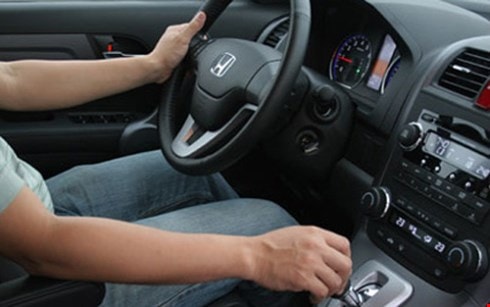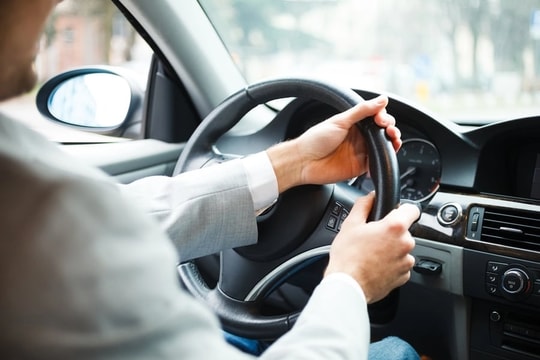"Tips" to stop the car when the brakes fail
To avoid dangerous situations, drivers must know how to stop the car when the brakes fail while driving on the road, especially on the highway.
Imagine you are driving on the highway or going down a hill and discover that your car brakes are broken or malfunctioning. How do you stop the car safely?
When the brakes fail, shift to a lower gear.
According to experts in the automotive field, brake failure does not only happen with old cars. New cars can also experience brake failure. When faced with this unexpected situation, drivers are often passive and flustered, leading to serious consequences.
Brake failure occurs most often with vehicles traveling long distances, on mountainous roads, and on difficult terrain. Because, when driving on these roads, drivers often use the brakes too much, while the brake system of most vehicles is driven by oil and assisted by vacuum gas, so when used too much, it is easy to generate heat, making the brake pads dull, the brakes do not work, causing the cupen in the brake cylinder to flip, and each time the brake is applied, the brake fluid is lost, leading to brake failure.
 |
| When you discover brake failure, the first thing you need to do is stay calm, panic will only make the situation worse and more difficult to fix. |
When the brakes fail, calmly pull the handbrake, then try to shift the gear lever back to position 1 to slow down the car to the slowest speed. Note, do not shift to 0 (N) for too long, because when the car is going downhill and you press the clutch to shift to 0, the car will go faster and it will be very difficult to get back into gear because the engine speed and the wheel rotation speed are no longer synchronized.
For example, your car is going downhill in 3rd gear and suddenly loses its brakes. To shift to 1st gear, you press the clutch, shift to 0; release the clutch and accelerate hard to synchronize the engine speed with the wheel speed; then press the clutch, shift to 2nd gear. At this time, the car will stop and jerk suddenly. You should shift the gear lever to 1st gear. The car's speed is very slow. You can stop the car completely by releasing the handbrake lever and quickly pulling hard to stop the car completely.
When the brakes fail, you should continuously pump the brake pedal several times to temporarily restore the hydraulic pressure in the leaking pipe... Then, stop the car completely by leaning against the guardrails, steel railings, walls, curbs, cliffs...
Brake does not work, immediately release the accelerator
As soon as you notice the brakes are not working, release the accelerator pedal immediately. If your vehicle has cruise control, turn it off (if it is activated).
Continue to apply the brakes and feel for the cause. If the brakes are soft and pressed all the way to the floor, there may be a loss of fluid due to a broken line. Try applying them several times to see if the pressure can be restored. However, if the brake pedal is hard, the brake system has a clogged hydraulic line, or the brakes are locked. However, sometimes it can also be due to an object blocking the bottom (like a water bottle falling into the slot, a floor mat, etc.).
Repeated braking. Repeatedly pumping the brakes in an attempt to regain control of the system, especially in vehicles with ABS, can cause the ABS to activate.
Shift to a lower gear (automatic transmission is 1, 2 or S, L...). A lower gear helps the car slow down thanks to the engine's gear braking force. With a manual transmission, shifting to a lower gear must be done step by step, not suddenly shifting to 1, 2, but gradually shifting down if in a higher gear depending on the operating speed. Shifting too low at high speed can destroy the transmission system and inertia, causing loss of control. Remember, never turn off the engine because then the steering system gradually loses power assistance, making it very heavy and difficult to control. In addition, at high speed, a sudden engine stop will cause the car to lose control due to inertia.
Use the handbrake
This brake is also called the parking brake (when the car stops). But because this brake only works on the rear wheels, it must be pulled slowly to have enough braking force. Doing it suddenly can cause the car to lose control and skid due to the rear wheels being locked. You need to hold the handbrake release knob to lower it when you feel the car is losing control.
Keep a lookout ahead for obstacles or other vehicles to allow more time to safely handle a brake failure.
Quickly turn on your hazard lights (triangle symbol) to warn other vehicles. You can flash your high beams and honk your horn repeatedly to attract attention. If there is someone in the passenger seat, ask them to open the window and give a verbal signal (in a crowded area).
Zigzag if possible. If you have space, repeatedly swerving left and right can help slow you down. Be careful not to do this at high speeds as it can cause the car to flip over if you have poor steering.
Use obstacles to reduce speed. This is one of the limited options because your car will have to rely on other cars or obstacles to reduce speed. You can take advantage of roadside plants or muddy roads to get the car in. You can even use the median strip or sidewalk to rub the car to create friction./.
According to VOV.VN
| RELATED NEWS |
|---|


